► We take a closer look at the all-new Volvo S90
► It’s a key car in Volvo’s continued renaissance
► Finally, something different from the Germans!
By 2020 Volvo hopes to have established itself as a true premium alternative, but the success of XC90 – positive response to interior and exterior design, far higher than predicted take-up of top-end powertrains and trim options, key player in the best sales month (November 2015) in the company’s 88-year history – and the fact that the talismanic SUV informs much of the new S90 saloon would suggest the ambitious, rejuvenated Swedes are making headway.
Now of course Ford-free, Geely-funded (to the tune of $11 billion over five years), ambitious and proudly Swedish, the buzz at Volvo is palpable. Design chief Thomas Ingenlath can’t stifle a chuckle as he explains how this all-new S90 ‘waves goodbye to dressed-up Mondeo proportions’. It’s the same story on the chassis side, where men such as vehicle dynamics manager Stefan Karlsson can’t hide their glee at having fit-for-purpose double wishbone and composite leafspring suspension systems to play with. ‘The body control and responses on this car are really nice, really tight,’ he says, smiling confidently like Lewis Hamilton after his first drive of the all-conquering hybrid Merc F1 car. ‘And there is no heaving or floating like an old Volvo.’
The Swedes moved bodly upmarket with the XC90 and the S90 will follow suit. Full pricing will be confirmed with the car’s unveiling at the Detroit motor show, but entry-level D4 manuals will start at £32k. The T8 XC90 starts at £60k, and similarly swish S90s won’t be shy either. Can Volvo compete in such lofty fiscal territories?
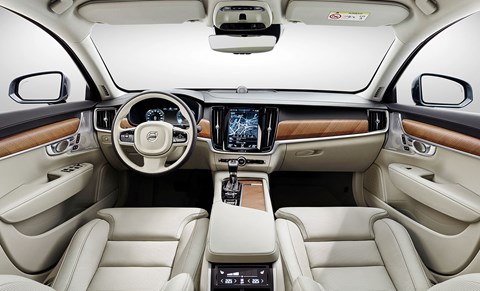
The raw materials certainly have potential. S90 rides on the scalable SPA chassis that underpins the fine-driving XC90. Modular, for economies of scale, backward compatibility and lean development cycles (Volvo is working to cut these from 36 months to 20 as it launches the remainder of its next-generation portfolio), the platform was designed around four-cylinder petrol and diesel engines and plug-in hybrids. Suspension is by transverse leafspring at the rear (to save weight, boost boot space and fight body roll) and double wishbones up front, with air suspension an upgrade option over the standard mechanical dampers. Volvo engineers also admit you can’t build a saloon to fight the Germans and not offer something M Sport-esque at a later date, almost certainly under the Polestar banner.
Set-up is said to be distinctly different to XC90 and altogether more engaging, despite the closely related hardware. ‘First and foremost S90 is intended to be a relaxing car to drive,’ says chassis guru Karlsson. ‘You’re not going to break any Nürburgring lap records – the S90 is comfortable and relaxed in this touring specification, with great insulation, particularly on the air suspension, but body control, steering response and agility are so far ahead of what we had before. The handling is precise and the steering has very little slack. It’s tight; you turn the wheel and the car responds. In this respect it’s best in class. Coming from a BMW, you’ll enjoy this car. With this platform we’ve been able to deliver clean responses so you feel happy right away. When senior management drove the car for sign-off they all drove far faster than they have in any previous Volvo.’ We’ll take all this with a lorryload of salt, but our interest levels are piqued.
Engine options globally will include a T6 four-cylinder petrol (under consideration for the UK), D4 and D5 diesels and the T8 plug-in hybrid. The T8 and D5 will use Volvo’s eight-speed auto, while the D4 will also be available with a six-speed manual. All-wheel-drive D5s (232bhp, 354lb ft, 7.3sec 0-62mph, 55mpg and 133g/km CO2) will spearhead UK sales in the summer, followed by the D4 (187bhp, 295lb ft, 8.2sec 0-62mph, 69mpg, 109g/km CO2) and the faintly ballistic 401bhp T8. The new D5 engine enjoys more power and a sharper throttle response than the existing XC90 D5 motor thanks to the use of compressed air to instantaneously spool the turbo.
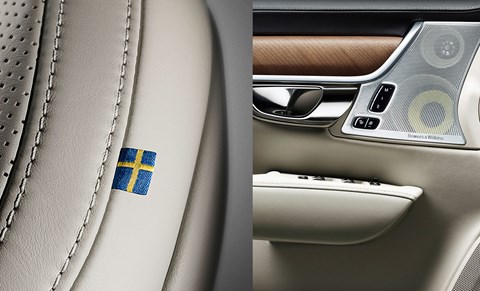
‘T8 is important in America, where they have this performance V8 heritage, but it’ll also appeal to European drivers who appreciate strong acceleration and safe overtaking performance,’ explains Volvo’s busiest engineer, e-propulsion, electrics/electronics and vehicle dynamics vice president Thomas Muller. ‘It has performance when you need it but it also reflects the fact that our customers are environmentally responsible, and that they’re not into counting cylinders.’ The T8 will hit 62mph in 5.2sec while also offering 44g/km Co2 and 149mpg. It’s expected to account for 10% of UK sales, though demand for the same powertrain in the XC90 has proved stronger than estimated at 20%.
Exterior design adheres to Ingenlath’s inspired new formula, with a twist on the new corporate face that deftly references the P1800’s concave grille. From most angles it’s a striking car, and the short front overhang and vast wheels make for some pleasing proportions, but the back end oddly calls to mind VW’s ultra-eco XL1… Perhaps the V90 estate, due later in 2016, will provide a more resolved rear end.
Inside, war has been declared on visible plastic. Instead, finely stitched leather, Scandi-style open-pore timber and jewellery in the form of glass controls and chrome frames are all implemented with a charming lightness of touch. S90 is a far bigger car than the S80 it replaces and front and rear legroom (helped by stylish, super-slim front seats) and bootspace are all generous. HMI is via the XC90’s show-stealing central touchscreen, and the tech arsenal will include myriad collision avoidance systems, a highway autopilot happy to take the helm at up to 80mph and Apple CarPlay.
If the XC90 was the lauded debut, S90 is the all-important second album. An XC90-esque reception would validate Volvo’s upmarket push and bolster that premium alternative status it seeks. Besting the S80 is not the issue – Jag’s XF and the next-gen Germans will be the real test of Gothenburg’s latest disruptor.
That establishment in full…
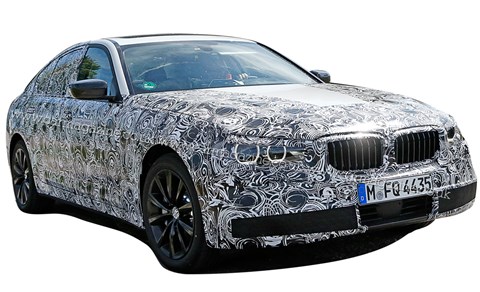
> BMW 5-series: Will borrow much from the tech powerhouse 7-series, including strategic use of carbon, gesture control and a raft of autopilot driver assistance systems.
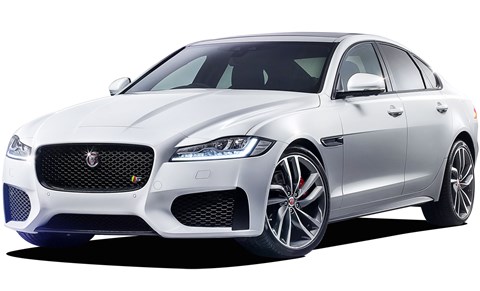
> Jaguar XF: We wish the styling was a little braver but at least the body’s wrought in lightweight aluminium and the Jag drives like a dream on tricky UK roads.

> Audi A6: Last updated in 2014 and still a contender on refinement if not driving thrills. If the new A6 in 2017 steers like the new A4 we’re in.
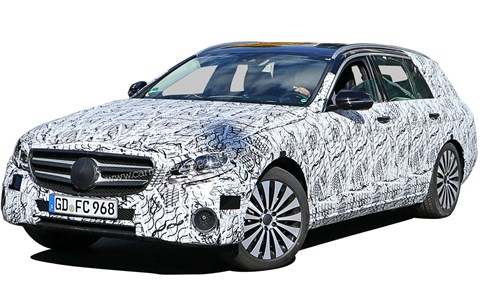
> Mercedes E-class: V6 engines are out – in come straight-sixes, plug-in diesels and a sub-100g/km CO2 downsized four with 122bhp.